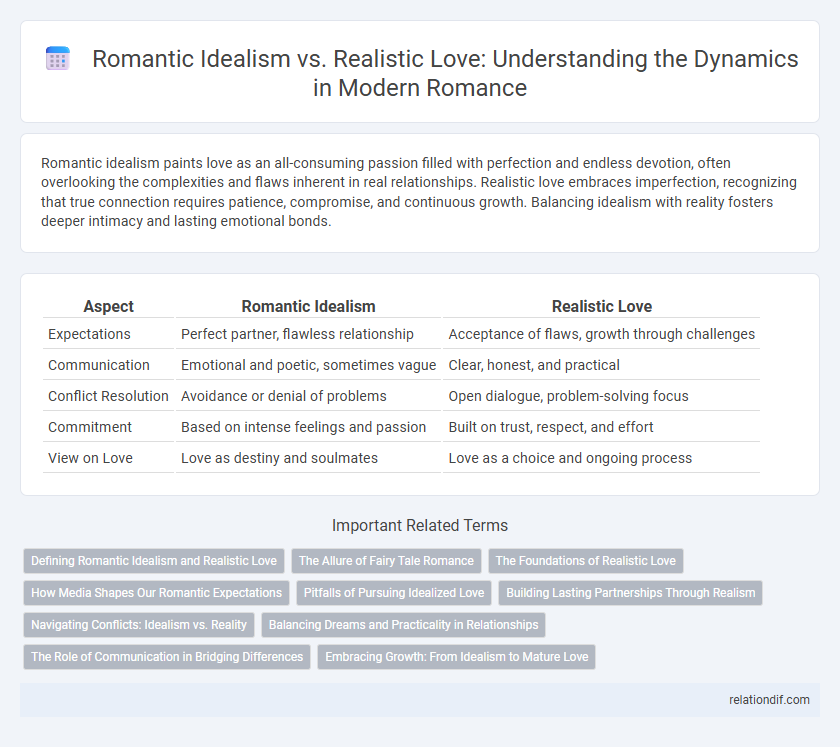Romantic idealism paints love as an all-consuming passion filled with perfection and endless devotion, often overlooking the complexities and flaws inherent in real relationships. Realistic love embraces imperfection, recognizing that true connection requires patience, compromise, and continuous growth. Balancing idealism with reality fosters deeper intimacy and lasting emotional bonds.
Table of Comparison
| Aspect | Romantic Idealism | Realistic Love |
|---|---|---|
| Expectations | Perfect partner, flawless relationship | Acceptance of flaws, growth through challenges |
| Communication | Emotional and poetic, sometimes vague | Clear, honest, and practical |
| Conflict Resolution | Avoidance or denial of problems | Open dialogue, problem-solving focus |
| Commitment | Based on intense feelings and passion | Built on trust, respect, and effort |
| View on Love | Love as destiny and soulmates | Love as a choice and ongoing process |
Defining Romantic Idealism and Realistic Love
Romantic idealism envisions love as a perfect, all-consuming passion often characterized by unwavering devotion and flawless harmony, idealizing emotional intensity and profound connection. Realistic love acknowledges human imperfections and embraces practical compatibility, mutual respect, and continuous effort to nurture the relationship despite challenges. Understanding these differing perspectives clarifies how individuals balance dreams of ideal romance with the everyday realities of sustaining lasting partnerships.
The Allure of Fairy Tale Romance
The allure of fairy tale romance captivates with its promise of perfect love, magical moments, and eternal happiness, often shaping expectations in relationships. Romantic idealism thrives on these enchanting narratives, creating a contrast with the challenges and compromises inherent in realistic love. Understanding this tension helps individuals appreciate the beauty of love while embracing the depth and resilience found in authentic partnerships.
The Foundations of Realistic Love
Realistic love is grounded in acceptance, empathy, and mutual respect, recognizing imperfections without the rose-colored lens of idealism. It values consistent communication and emotional growth over fleeting passion, building a sustainable relationship framework. The foundations of realistic love prioritize shared values and authentic connection, fostering resilience through challenges and change.
How Media Shapes Our Romantic Expectations
Media often portrays romantic idealism through flawless love stories, influencing audiences to expect perfection in relationships. This distorted representation contrasts with realistic love, which involves complexities, compromises, and emotional growth. As a result, individuals may develop unrealistic expectations that challenge their ability to navigate authentic romantic experiences.
Pitfalls of Pursuing Idealized Love
Pursuing idealized love often leads to unrealistic expectations that can cause disappointment and emotional distress when reality fails to align with fantasies. Romantic idealism may blur important flaws and compatibility issues, resulting in neglect of genuine connection and mutual growth. Recognizing the pitfalls of idealized love encourages embracing realistic relationships grounded in trust, communication, and acceptance.
Building Lasting Partnerships Through Realism
Romantic idealism often paints love as a perfect, effortless connection, yet lasting partnerships thrive on realistic understanding and mutual effort. Embracing flaws and prioritizing communication fosters trust and resilience, essential components in enduring relationships. Couples who balance passion with practical expectations are more likely to build strong, sustainable bonds over time.
Navigating Conflicts: Idealism vs. Reality
Romantic idealism often envisions love as flawless and eternal, setting expectations that clash with the complexities of real relationships where misunderstandings and imperfections are inevitable. Navigating conflicts requires balancing idealistic hopes with realistic acceptance, fostering communication and empathy to resolve differences without disillusionment. Couples embracing both passion and pragmatism tend to build resilient bonds, transforming conflicts into opportunities for deeper connection.
Balancing Dreams and Practicality in Relationships
Romantic idealism often envisions love as a flawless, passionate experience, but realistic love acknowledges imperfections and the effort required to grow together. Balancing dreams and practicality involves embracing both the emotional intensity of romance and the everyday commitments that support long-term partnership. Successful relationships thrive when partners harmonize idealistic aspirations with pragmatic understanding, fostering both passion and stability.
The Role of Communication in Bridging Differences
Effective communication serves as the crucial link between romantic idealism and realistic love, enabling partners to express expectations and navigate conflicts with clarity. Honest dialogue fosters mutual understanding, allowing couples to align their desires while managing idealized notions with practical experiences. Emphasizing empathetic listening and transparent sharing strengthens emotional bonds, transforming abstract romantic ideals into tangible, sustainable relationships.
Embracing Growth: From Idealism to Mature Love
Romantic idealism often paints love as flawless passion filled with grand gestures, but mature love embraces growth by acknowledging imperfections and fostering deep emotional connection through shared experiences. Shifting from idealism to realistic love involves cultivating empathy, patience, and communication, which strengthen bonds and allow partners to evolve together. Embracing this transformation promotes lasting intimacy grounded in authenticity rather than fleeting fantasy.
romantic idealism vs realistic love Infographic

 relationdif.com
relationdif.com